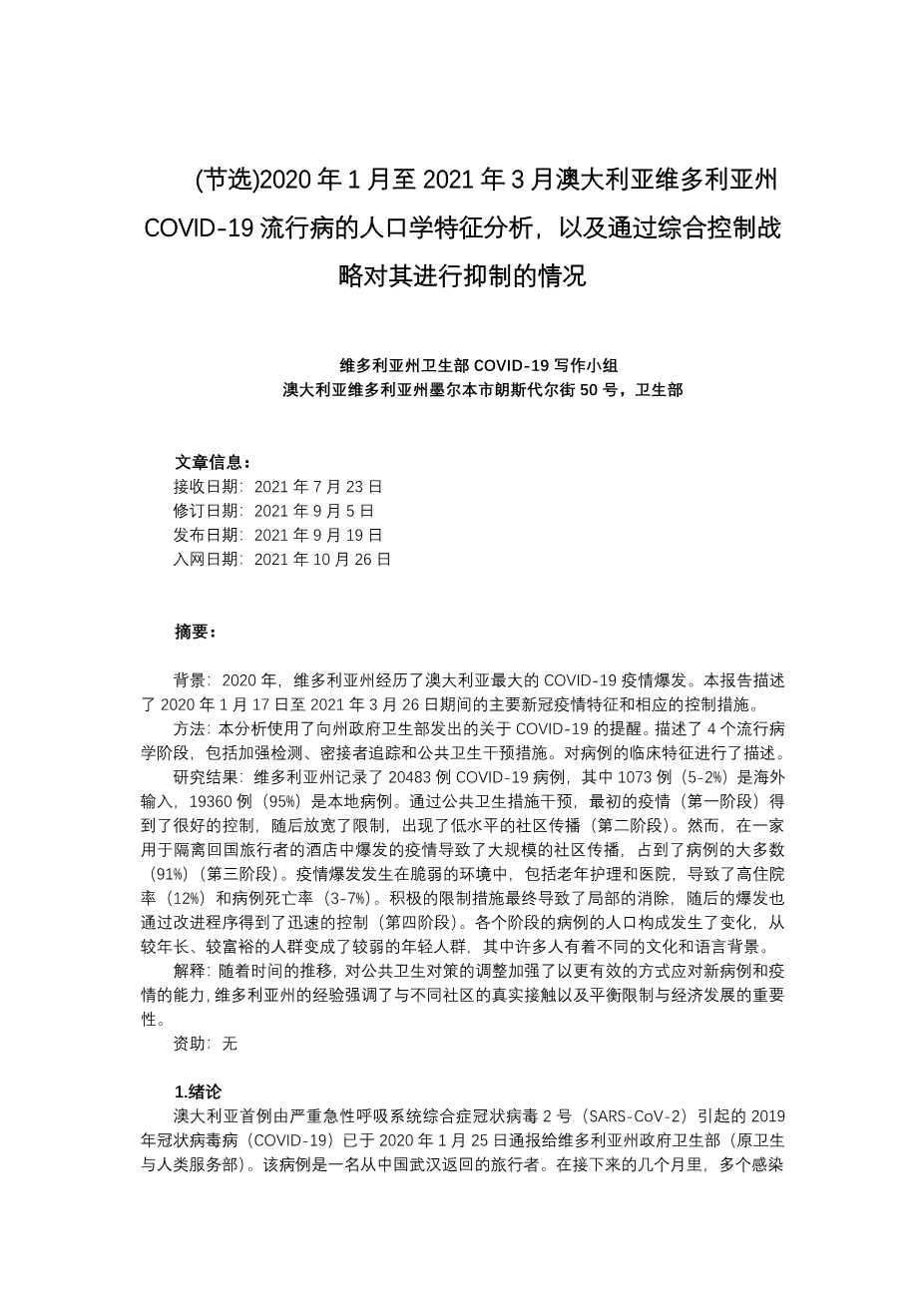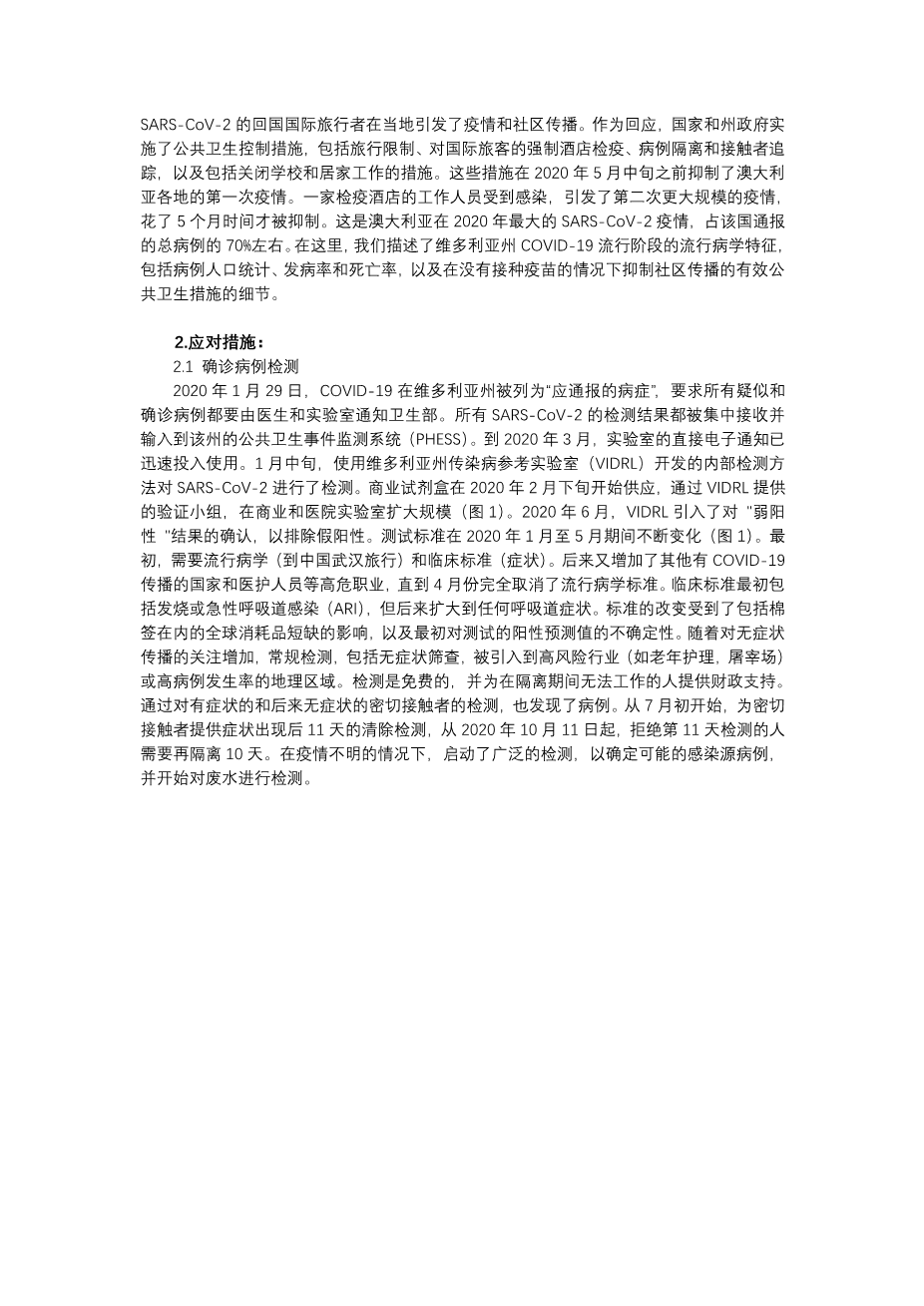(Excerpt From)Population-based analysis of the epidemiological features of COVID-19 epidemics in Victoria, Australia, January 2020 – March 2021, and their suppression through comprehensive control strategies
Victorian Department of Health COVID-19 writing group,
Department of Health, 50 Lonsdale Street, Melbourne, Victoria 3000, Australia
A r t i c l e i n f o:
Article history: Received 23 July 2021
Revised 5 September 2021
Accepted 19 September 2021
Available online 26 October 2021
A b s t r a c t:
Background: Victoria experienced the greatest burden of COVID-19 in Australia in 2020. This report describes key epidemiological characteristics and corresponding control measures between 17 January 2020 and 26 March 2021.
Methods: COVID-19 notifications made to the State Government Department of Health were used in this analysis. Epidemiological features are described over 4 phases, including enhancements to testing, contact tracing and public health interventions. Demographic and clinical features of cases are described.
Findings: Victoria recorded 20,483 cases of COVID-19, of which 1073 (5bull;2%) were acquired overseas and 19,360 (95%) were locally acquired. The initial epidemic (Phase I) was well-contained through public health interventions and was followed by relaxation of restrictions and low-level community transmission (Phase II). However, an outbreak in a hotel used to quarantine returned travellers led to wide-scale community transmission accounting for a majority (91%) of cases (Phase III). Outbreaks occurred in vulnerable settings including aged care and hospitals, contributing to high hospitalisation (12%) and case fatality rates (3bull;7%). Aggressive restrictions ultimately led to local elimination, and subsequent outbreaks have been swiftly managed with improved processes (Phase IV). The demographic composition of cases evolved across phases from an older, wealthier population to a less advantaged younger population, with many from culturally and linguistically diverse backgrounds.
Interpretation: Over time, adaptations to the public health response have strengthened capacity to respond to new cases and outbreaks in a more effective manner. The Victorian experience underscores the importance of authentic engagement with diverse communities and balancing restrictions with livelihoods.
Funding: None
1. Introduction
Australiarsquo;s first case of coronavirus disease 2019 (COVID-19), caused by the severe acute respiratory syndrome coronavirus 2 virus (SARS-CoV-2), was notified to the Victorian Government Department of Health (formerly the Department of Health and Human Services) on 25 January 2020. The case was a traveller returning from Wuhan, China . In the following months, multiple returning international travellers infected with SARS-CoV-2 seeded local outbreaks and community transmission. In response, national and state public health control measures were implemented, in- cluding travel restrictions, mandatory hotel quarantine for international arrivals, case isolation and contact tracing, and community measures including school closures and working from home policies. These measures saw the suppression of the first epidemic across Australia by mid-May 2020. Infection of staff at a quarantine hotel initiated a second, larger epidemic that took 5 months to suppress. This was Australiarsquo;s largest SARS-CoV-2 epidemic in 2020, accounting for around 70% of the total cases notified in the country. Here we describe the epidemiology of COVID-19 epidemic phases in Victoria, including case demographics, morbidity and mortality, and details of effective public health measures that suppressed community transmission in the absence of vaccination
2. Methods:
2.1 Case detection
On 29 January 2020, COVID-19 was made a notifiable condition in Victoria, requiring all suspected and confirmed cases to be notified to the Department of Health by both medical practitioners and laboratories. All SARS-CoV-2 test results were received centrally and entered in the statersquo;s Public Health Event Surveillance System (PHESS). Direct electronic notification from laboratories was rapidly operationalised by March 2020. Testing for SARS-CoV-2 was available by mid-January using inhouse assays developed at the Victorian Infectious Diseases Reference Laboratory (VIDRL). Commercial kits became available in late February 2020, with scale-up at commercial and hospital laboratories (Figure 1) enabled by a validation panel supplied by VIDRL. Confirmation of “weak positive” results by VIDRL was introduced in June 2020 to rule out false positives. Testing criteria evolved between January and May 2020 (Figure 1). Initially, both epidemiological (travel to Wuhan, China) and clinical criteria (symptoms) were required. Other countries with COVID-19 transmission and high-risk professions such as healthcare workers were later added, until epidemiological criteria were dropped altogether in April. Clinical criteria initially included fever or acute respiratory infection (ARI), but were later broadened to any respiratory symptoms. Changes to the criteria were influenced by global shortages of consumables, including swabs, and initial uncertainty around the positive predictive value of tests. As concerns about pre-symptomatic transmission increased, routine testing, including asymptomatic screening, was introduced to target high-risk industries (e.g. aged care, abattoirs) or geographic regions with high case incidence. Testing was free-of-charge and financial support was provided to people unable to work while isolating . Cases were also detected through testing of symptomatic and, later, asymptomatic close contacts. Clearance testing was offered to close contacts 11 days post-symptoms onset from early July and, from 11 October 2020, individuals refusing d
剩余内容已隐藏,支付完成后下载完整资料


英语译文共 6 页,剩余内容已隐藏,支付完成后下载完整资料
资料编号:[590780],资料为PDF文档或Word文档,PDF文档可免费转换为Word
课题毕业论文、外文翻译、任务书、文献综述、开题报告、程序设计、图纸设计等资料可联系客服协助查找。


